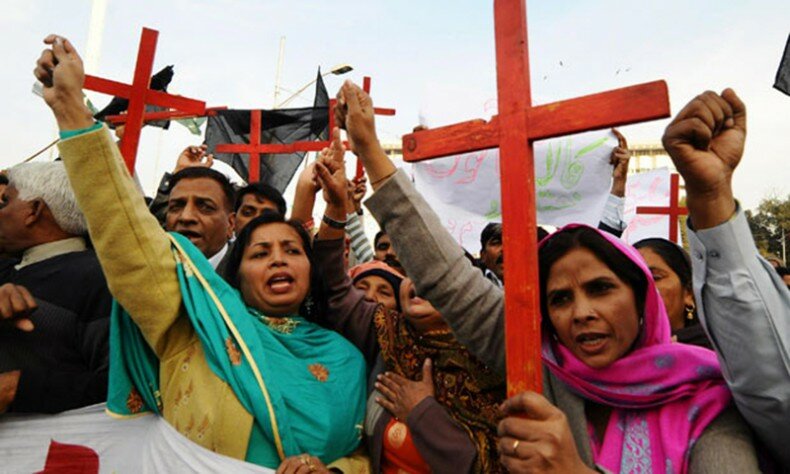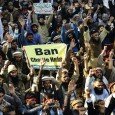By Shahzada Irfan Ahmed –
The barbaric killing of a Christian couple at Kot Radha Kishan speaks volumes not only about the societal decline but also calls for necessary amendments in existing laws to stop abuse of sensitive piece of legislation
How low is the level that humans can stoop to and to what extent they can go in their display of barbarity could be seen at a brick kiln in Kot Radha Kishan, in the suburbs of Lahore.
It was the place where a Christian couple – Shehzad and Saima – was recently burnt to death over blasphemy charges. The hapless husband and wife, who worked at the brick, were locked in a room by the owner’s men. They were dragged out of it by a violent mob that broke into it through the roof.
Both of them were beaten mercilessly, dragged along the breadth and length of the brick kiln after being tied to tractor trolley, carried to the burning fires of the ovens where bricks are baked and left there to turn into ashes. This horrific chain of events continued for quite long in the presence of around 600 people and less than a dozen policemen who did not dare stop the attackers.
According to witness accounts, the attackers were charged and tried to outdo each other in their bid to inflict injuries to the couple. They did this with a religious zeal and conviction and took their pictures with the bodies before they got engulfed in flames.
“They are destined to burn in hell after death for the sin they have committed. Let’s give them a taste of it in their life,” said a stoutly built man leading his own group of agitators who had come from a neighbouring village.
The scariest thing was that the mob had indulged in this orgy of inhumane torture with full impunity and was not deterred by the fact that several people, including two policemen, were making videos with the help of their cell phones. It was by no mean an impulsive act and everything had been planned well in advance. From the writing of the script to approaching locals in surrounding villages, making announcements from mosques about the alleged act of blasphemy, instigating them to punish the accused, transportation of resentful villagers to the brick kiln and timing of the attack, everything seemed planned.
If there was something that was not planned at all, it was the strategy that the state machinery should have adopted to handle this situation and save two precious human lives from being lost to a senseless spate of violence. A First Information Report (FIR) 475/14 about the incident was registered at Kot Radha Kishan that termed the blasphemy charge a lie. But unfortunately this realisation had come at a time when the damage had been done and the accused had been punished with death without giving them a chance to defend themselves.
Regardless of the facts pertaining to this case, one thing that is established is that the easiest way to target a minority community is to level a blasphemy charge against it. The accuser can then become the law enforcer, judge and executor-all at the same time. In most of the incidents, there were some ulterior motives behind launching of campaigns against minority communities and the accusers had not given a chance to the law to take its course. The tormentors win bails and acquittals while the victims, if they survive, are doomed to suffer throughout their life.
This brings one to the question that why such incidents continue to happen in identical fashion and that the state always fails in controlling them. Besides, what can be the ways to handle such situations in future is another question that needs to be answered.
The biggest problem is the lack of implementation of laws and the reluctance of police to use force where mob violence is instigated for religious reasons, says Kashif Nawab, Team Leader at Social Action for Transformation of Humanity (SATH-Pakistan), an NGO working for minorities and human rights that had led a fact finding mission to the place.
He tells Pique that on the basis of interviews of eyewitnesses, they found out that there were some other contentious issues that led to the creation of this situation. For example, he says people told them that there were attempts of force conversions but the couple resisted and that Munshi Shakeel, who looks after the kiln, was constantly trying to develop illicit relations with Shama. Shehbaz, her husband, had come to know about this and quarreled with Shakeel -something that led to escalation of tensions beyond controllable limits. Shakeel vowed to avenge on them and suspectedly created the whole scene.
Kashif says it was alleged that the couple had desecrated Holy Quran and disposed of amulets carrying Quranic scriptures that were used by Shehzad’s father who practiced black magic till he died a few days ago. But this could not be proved and the FIR also denies it. When Shehzad and Shama tried to run for life, they were locked in a room on pretext that they had to repay a loan of Rs 60,000 and could not be allowed to move till they paid it off, he shares. Announcements about alleged blasphemy were made from five mosques which was itself a violation of the law on loudspeaker’s use, he adds.
Kashif says a few policemen reached at the scene but could not control the situation. They remained there all the time but as silent spectators. Secondly, Jawwad Qamar, DPO Kasur called Reserve Police from Lahore that took two hours to reach at the scene. By that time the couple had been burnt to issues. An excuse given by the senior officers was that most of the police force had been performing Moharram duty and was not available that day.
Haroon Suleman Advocate, who has contested blasphemy cases, is convinced that such incidents cannot be stopped without punishing the culprits. But unfortunately, the culprits are not punished and they win bails and acquittals over the time. The police that comes under pressure registers blasphemy cases under Section 295-C without ascertaining the facts and the burden of proof shifts to the accused who have to run for their life.
The Joseph Colony is a case in point. All the attackers have been released but Sawan Masih-the blasphemy accused-has been awarded death sentence by the court. There were no punishments for attackers in Gojra case as well as in Rimsha case in Islamabad. In the latter case, a witness said that the cleric had intentionally placed pages from Holy Quran in garbage to implicate the girl. Had the cleric been charged with blasphemy and punished things would have been far different from what they are now, he adds. The people of Joseph Colony are living in reconstructed houses but they still do not have ownership rights. The people who got acquitted are a constant threat as they can avenge on them any time.
A senior police of official who is privy to many high-level meetings on how to handle such situations accepts that police did not take the Kot Radha Kishan incident seriously. It underestimated the threat and one reason for this is that most of the times real situation is not conveyed to the high-ups. “May be this happened in this case.”
He tells Pique that it was in the knowledge of the police and the concerned Deputy Superintendant of Police (DSP) could have acted to disperse unlawful assembly under section 141 of Pakistan Penal Code (PPC). Tear gas shelling, baton-charge and aerial firing are a few measures that could be taken. He says the Counter Terrorism Department (CTD) and the Special Branch regularly monitor speeches of prayer leaders but it was strange that they did not take notice of this here and failed to suggest action against them.
The officer says the situation could have been handled by providing significant strength at the place, engaging notables of the area, involving religious leaders especially the leaders of the active sect and most importantly moving of the target (the couple) to a safer place. The only saving grace in Joseph Colony incident was that no life was lost and the police and the locals ensured that all the inhabitants moved from there.
If relevant laws are implemented, almost all the attackers in such cases can be declared culprits under Section 144 of PCC that talks about joining unlawful assembly armed with deadly weapon. It states: “Whoever, being armed with any deadly weapon, or with anything which, used as a weapon of offence, is likely to cause death, is a member of an unlawful assembly/shall be punished with imprisonment of either description for a term which may extend to two years, or with fine, or with both.
So the situation is that more than 50 people have been nominated in the FIR and most of them have been arrested. The police have become complainant to avoid compromise among the heirs of the victims and the accused. The real test of the government is to ensure that each and every culprit gets the punishment prescribed in law for the crime they have committed. This will not bring the two back but save others from becoming victims of similar show of barbarity.
The writer is a journalist based in Lahore































































































